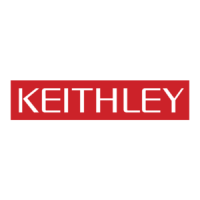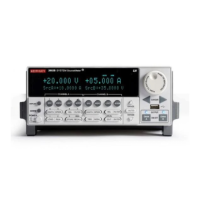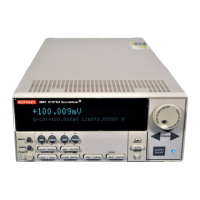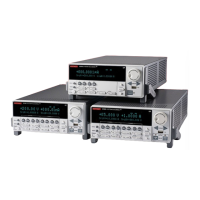7: TSP command reference Series 2600B System SourceMeter® Instrument
7-24 2600BS-901-01 Rev. C / August 2016
Details
The reading buffer fill count sets the number of readings to store before restarting at index 1. If the
value is zero (0), then the capacity of the buffer is used. Use this attribute to control when the SMU
restarts filling the buffer at index 1, rather than having it restart when the buffer is full.
If the bufferVar.fillcount attribute is set to a value higher than the capacity of the buffer, after
storing the element at the end of the buffer, the SMU will overwrite the reading at index 1, the reading
after that will overwrite the reading at index 2, and so on.
This attribute is only used when the bufferVar.fillmode attribute is set to smuX.FILL_WINDOW.
For dedicated reading buffers, all buffer attributes are saved to nonvolatile memory only when the
reading buffer is saved to nonvolatile memory.
Example
smua.nvbuffer1.fillcount = 50
Sets fill count of dedicated reading
buffer 1 (source-
measure unit (SMU)
channel A) to 50.
Also see
bufferVar.fillmode (on page 7-24)
bufferVar.fillmode
This attribute sets the reading buffer fill mode.
Type TSP-Link accessible Affected by Where saved Default value
Usage
fillMode = bufferVar.fillmode
bufferVar.fillmode = fillMode
The reading buffer fill mode; set to one of the following:
• 0 or smuX.FILL_ONCE: Do not overwrite old data
• 1 or smuX.FILL_WINDOW: New readings restart at index 1 after acquiring reading at
index bufferVar
The reading buffer; can be a dynamically allocated buffer (user-defined), or a
dedicated reading buffer (such as
)
Details
When this attribute is set to smuX.FILL_ONCE, the reading buffer will not overwrite readings. If the
buffer fills up, new readings will be discarded.
When this attribute is set to smuX.FILL_WINDOW, new readings will be added after existing data until
the buffer holds bufferVar.fillcount elements. Continuing the sequence, the next reading will
overwrite the reading at index 1, the reading after that will overwrite the reading at index 2, and so on.
For dedicated reading buffers, all buffer attributes are saved to nonvolatile memory only when the
reading buffer is saved to nonvolatile memory.
